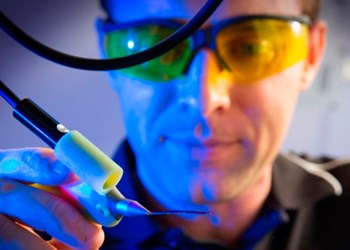Handheld Surgical Pen Writes With Stem Cells

Australian scientists have introduced a mobile 3D printing device that surgeons can use during an operation to sculpt an implant made from living cells. In their most recent proof-of-concept study, the researchers reported that their BioPen could carry and support stem cells with a 97 percent rate of viability.
In 2013, researchers from the Australian Research Council Center of Excellence for Electromaterials Science (ACES), headquartered at the University of Wollongong (UOW), first introduced the BioPen, which they said could reduce surgery times and accelerate bone and cartilage regeneration. The team, led by ACES director Gordon Wallace, designed the device by building on previous research, in which they regrew knee cartilage on 3D scaffolds.
The BioPen works by packing living cells into biopolymers, injecting them into the site of damaged bone, and solidifying them with a low-powered UV light source. Researchers noted in a press release that the biopolymers can be loaded with drugs and growth factors to encourage functional tissue and bone development.
This technology, said researchers, could prove valuable in situations where the precise geometry of the needed implant cannot be anticipated before surgery. Peter Choong, director of Orthopedics at St. Vincent’s Hospital in Melbourne, remarked that the BioPen could be ready to go in emergency operations to repair severe bone damage and “help surgeons design and personalize solutions for reconstructing bone and joint defects in real time.”
For the past three years, scientists at ACES have been working to develop a biomaterial that can optimize the BioPen’s “ink” for maximum living cell viability. In 2014, researchers suggested that seaweed would play a critical role in the BioPen’s development.
In a recent study published in Biofabrication, the ACES team wrote, “in vitro experiments demonstrated that human adipose stem cells maintain high viability (>97 percent) one week after biopen printing in gelatin-methacrylamide/hyaluronic acid—methacrylate hydrogel.” According to the scientists, the technology is viable for orthopedic surgeries and any case where tissue regrowth is critical.
“3D printing is a really exciting new way of creating smart devices for orthopedics,” said Choong in a YouTube video. “Under direct control of the surgeon, the biopen is able to repair a small defect in the cartilage. This allows the process to be personalized to the needs of the injury and the patient.”
Choong added that this type of research was made possible by close relationships between engineers and clinicians, who described their unmet needs and allowed the engineers to develop a solution.
“The biopen project highlights both the challenges and exciting opportunities in multi-disciplinary research,” said Wallace in a press release. “When we get it right we can make extraordinary progress at a rapid rate.”
